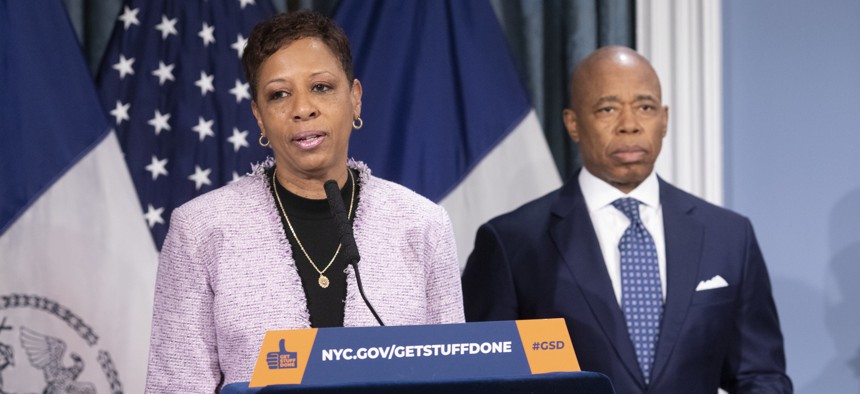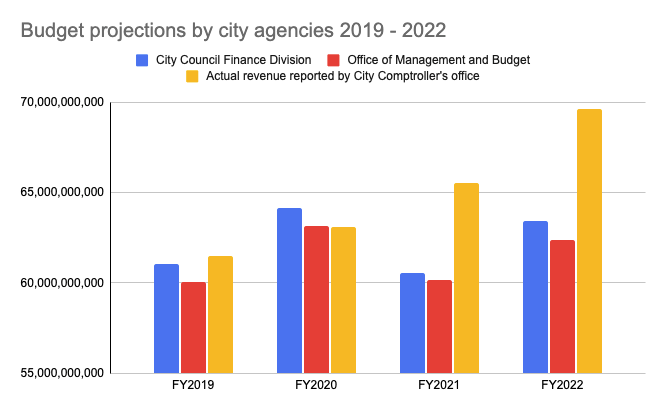Policy
Why does the NYC Council think there’s more money to spend than Eric Adams?
City Hall and the City Council often have different budget projections – and the council has been more accurate in recent years.

If there is an extra $2.7 billion that could be used to fund agencies and shield the city from rainy days, why wasn’t it included in Adams’ preliminary budget proposal? John McCarten NYC Council Media Unit
Are the mayor’s office and City Council crunching different numbers?
At a press conference in City Hall’s rotunda earlier this month, New York City Council leaders announced they identified an extra $2.7 billion of revenue in the city’s budget that Mayor Eric Adams’ administration left out of estimates in its preliminary budget proposal in January.
The $2.7 billion over fiscal years 2023 and 2024 could help address major costs, such as those associated with the asylum-seeker crisis, as well as help reverse cuts to agencies, Council Speaker Adrienne Adams and Finance Committee Chair Justin Brannan said at the April 3 press conference. In January, Adams presented a preliminary expense budget totaling $102.7 billion.
If there is, in fact, an extra $2.7 billion that could be used to fund agencies and shield the city from rainy days, why wasn’t it included in Adams’ preliminary budget proposal? The answer isn’t the Council’s finance analysts finding a few billion dollars of change between the couch cushions, but rather it’s a routine mismatch between City Hall’s tax revenue projections and the City Council’s tax revenue projections.
The $2.7 billion in additional resources over fiscal years 2023 and 2024 comes largely from the council projecting higher property tax, personal income tax and sales tax revenues than the Mayor’s Office of Management and Budget projected in January. (A significant piece of it also comes from budget reserves for this fiscal year that the council said could be rolled into fiscal year 2024.)
The discrepancy between tax revenue projections presented by the Office of Management and Budget and those presented by the City Council’s Finance Division is not anything new. City budget experts, as well as both City Hall and the City Council, readily acknowledge that the mayor’s budget office tends to be more conservative, while the council tends to be more optimistic in their outlook – though they may not choose those terms. Alternative tax revenue projections, including from the Independent Budget Office and city comptroller’s office, tend to fall somewhere in between.

It’s normal for these differences to exist. Forecasting, several budget experts said, is not a science. While analysts all tend to rely on similar macroeconomic models and economic indicators, they might weigh those indicators differently or use different formulas to land at their projections.
But there’s less agreement about who, between the City Council and City Hall, is usually closer to the mark at the end of each fiscal year. Both the City Council and City Hall said that their forecasts have historically been more accurate, but an analysis by City & State showed that in each of the past four fiscal years, the council’s total tax revenue projections at the time of the executive budget were closer to what the comptroller’s office reported as the actual total tax revenue at the end of the end of each fiscal year. In fiscal year 2022, for example, tax revenues totaled about $69.6 billion, according to an annual report from the city comptroller. At the time of the executive budget – several months before the start of that fiscal year – the mayor’s budget office projected that tax revenues would reach $62.4 billion, while the City Council’s Finance Division projected that they would reach $63.5 billion, according to a report by the council’s Committee on Finance.
The mismatch between the administration’s and the council’s revenue projections has strategic roots. As the city’s budget authority, the mayor’s budget office is motivated to play it safe, rather than overshoot and cause the city to spend more than it expects to take in, experts said. “As a budget office, I think you always want to have more revenue than you thought, rather than less,” said Ana Champeny, vice president for research at the Citizens Budget Commission. “The other monitors have a little more freedom to say where they think the revenues may fall, given that there's little downside risk if they're wrong. The city comptroller, the (Independent Budget Office), the City Council, the state comptroller – they're all slightly higher than (Office of Management and Budget) on the forecast.”
Some insiders also suggested that there are strategic reasons for the mayor’s budget office to hedge a bit with its revenue projections and for the City Council to take a more optimistic view. One former City Council central staffer who asked not to be named in order to speak openly about the budget process described the mismatch between the council and mayoral administration as “very common.” “They want to always make believe there’s less than there is,” the former staffer said of the mayor’s budget office. “And the council wants to usually add funding to the budget.”
City Council leaders have preferred to characterize their outlooks as “realistic” as opposed to “optimistic.” “We are charter-mandated to allocate the finite amount of revenue the city takes in. We are required by law to balance the budget,” Brannan, chair of the council’s Committee on Finance, said in an emailed statement. “So for our economists it’s not about is the glass half empty or half full, it’s about being objective.”
A spokesperson for City Hall declined to comment on the administration’s revenue projections. But City Hall has been adamant that it is not putting forward an austerity budget, and that the latest round of savings that agencies have been instructed to execute are necessary to weather an uncertain fiscal future. “The city faces significant fiscal and economic headwinds, including more than $4 billion in migrant costs by next year, funding labor settlements, and potential cuts and cost shifts from the state, which require prudent fiscal planning to ensure that we are spending within our means,” mayoral spokesperson Jonah Allon said in response to the council’s budget response in early April. “The City Council’s failure to account for $4.2 billion in related asylum-seeker costs or potential state cuts is unrealistic and does not properly recognize the city’s current and upcoming fiscal challenges.”
The Citizens Budget Commission has also warned that even if the additional funding that the council identified in its budget response is there, it doesn’t address large out-year budget gaps.
The figures in the City Council’s preliminary budget response – and the administration’s preliminary budget, for that matter – are just initial estimates. Both the mayor’s budget office and the City Council typically adjust their revenue estimates up in the executive budget.
The Adams administration is expected to present its executive budget for fiscal year 2024 on Wednesday.

NEXT STORY: More mental health crisis respite centers, in NYC Council plan
